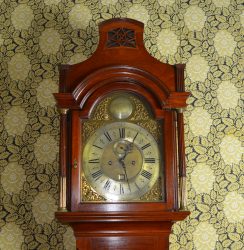

Tall Case Clock
c.1701-1727 (clockworks)
c. 1775-1800 (case)
Mahogany, Brass, glass, other metals
London (clockworks)
Philadelphia (case)
JJ.1987.6
This tall-case clock was owned by John Jay and is well documented in Jay’s inventories as having been used in his various houses. The clock came with Jay when he retired to this house in 1801 and stayed in the home for 6 generations. Eleanor Jay Iselin, John Jay’s great-great granddaughter was the last full-time inhabitant of the Jay homestead, and the clock was still in the home during her time. When Jay died, he left his Grandfather’s clock to his son William. The clock has early 18th century clockwork by London-based William Threlkeld and an empire-style mahogany case from the late 18th century.
The clock workings were bought in London, but the case is American made, from either Philadelphia or New York, and is from a later date (most likely the third quart of the 18th century). The clock workings were done by London-based William Threlkeld, ‘in ye strand’ around 1701-1727. We know this because of the brass plaque on the arched part of the clock face which has the inscription, “Will. Threlkeld London”. The dial plate is made out of solid brass, with a mounted pewter ring onto of the brass plate. The hours are in roman numerals with fleur-de-lis in between the numerals and the hands are made of steel. The four corner pieces have small brass designs of small bearded faces within an ornamental design and on either side of the small inscribed disk is a brass scroll with a winged sea monster.
The mahogany case is American, either made in Philadelphia or New York during the latter half of the 18th century. American clock cases had regional characteristics, but it is hard to know the exact location of where they came from as cabinetmakers rarely put their mark on clock cases.
This clock case is in the empire-style, which is characterized by its simple design and wood carving, with emphasis on straight lines and upright columns at the top. The hood, or top of the clock which houses the clock mechanism, has a high pediment with curved sides. There are turned colonettes, or decorative columns on the hood, with brass mounts on either side of a glass door, which is displaying the brass dial plate and ornamental designs. The hood sits on top of a long narrow case with a paneled door and quarter columns.
The story is that the case is much later than the clockwork because the original casing was damaged when John Jay moved from New York City to Albany during his time as Governor, (around 1798). The story seems possible as it was common to replace or substitute parts of the clock instead of replacing the entire thing, as they were very expensive; however, there are no reliable/definitive sources for the information/story.
The inner workings of the clock and the clock case were not made by the same people, which was typical of the time. Often, the clock work would be ordered separately from the clock case; in the 18th century, the clockwork was typically ordered from an English or European clockmaker who would ship the mechanics to America where the customer would then find a cabinetmaker to make the clock case.
Clocks, especially tall-case clocks, were uncommon in American households as they were very expensive. Only the wealthiest families bought them, but even then, they were still not very common among wealthy households. In the early 19th century, a tall-case clock cost around one year’s salary. It wasn’t until the mid-19th century that clocks became cheaper and as a result, the expensive tall-case clock went out of style.
You may view the Object of the Day Archives HERE
